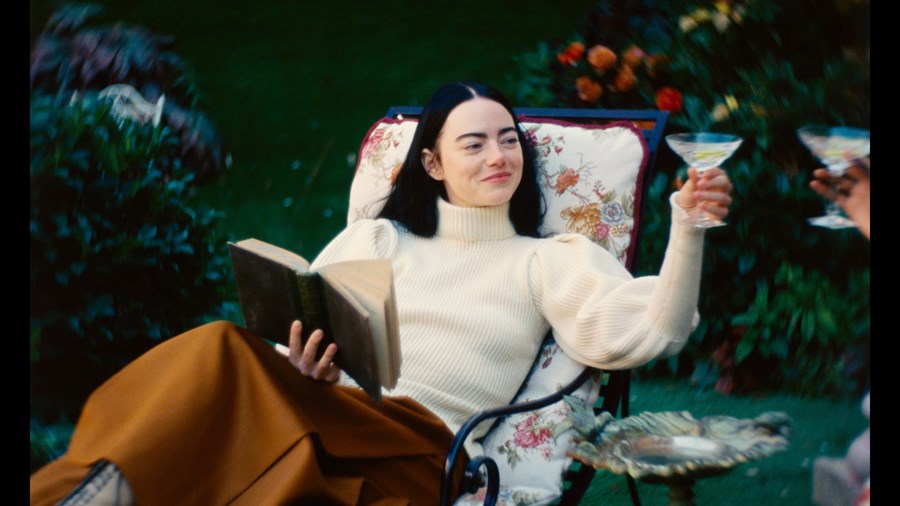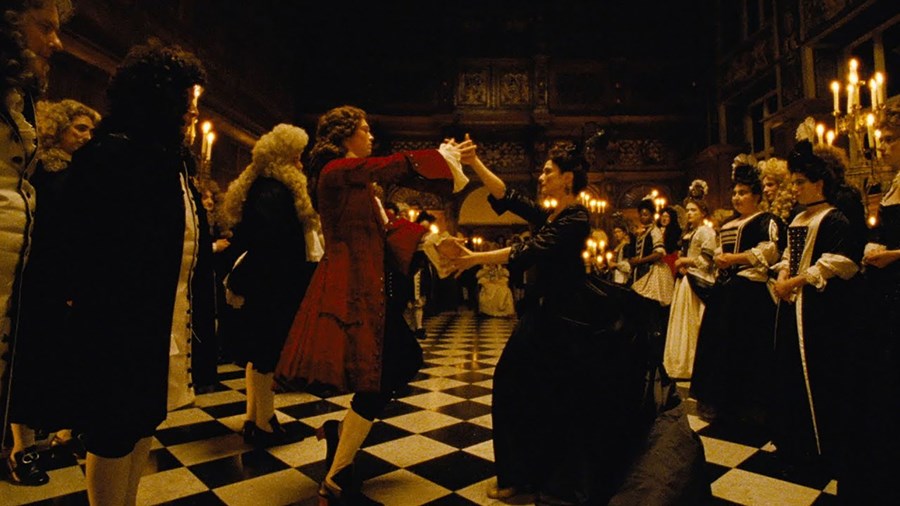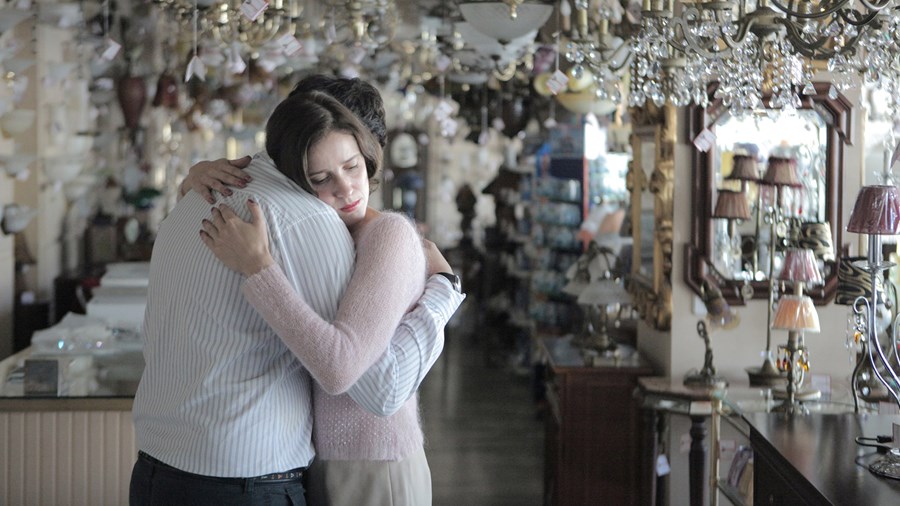From voguing in The Favourite to arrhythmic jumping in Poor Things, the dance sequences in the director’s oeuvre reflect wider themes of social rebellion, says Hannah Strong.

In Yorgos Lanthimos’ Poor Things, while making her first steps into the wide world, Emma Stone’s charming heroine Bella Baxter discovers many of the wonders that life has to offer, among them pastel de nata and communism. She embraces these new experiences with open arms, unburdened by the self-consciousness and cynicism that afflict so many of us once we reach the age of self-possession. Of course, this stems from the fact that Bella is a woman quite unlike any other, having had the brain of her unborn child transplanted into her body following a suicide attempt, but her wide-eyed eagerness to experience everything that the world has to offer – the good and the bad – is incredibly charming to witness, not least in the moment she discovers how to dance.
‘Understand me never lived outside God’s house,’ she explains in her broken babytalk to Duncan Wedderburn (Mark Ruffalo), the rakish gambler who whisked her away on a lavish steamliner. ‘So Bella so much to discover.’ Moments later – while Wedderburn dramatically seethes at the dinner table – Bella discovers the joy of dancing, while the ship’s band plays a percussion-heavy instrumental. As the well-heeled couples around her twirl slowly in stagnant waltzes, Bella jumps and shakes excitedly. Even Wedderburn’s attempt to lead her in a more traditional dance is met with resistance: she turns the tables, continually wriggling out of his grasp as he attempts to rein her in.
It’s a neat metaphor for their relationship, as it happens, which becomes untenable as Bella’s lust for life outstrips her interest in the handsome but vainglorious Wedderburn – but the relatively short sequence also situates Bella within the wider world of Lanthimos’ cinema: one where dance offers a temporary sort of rebellion from a world of rules and restrictions.

Poor Things (2023)
It’s no surprise that Lanthimos has consistently displayed an interest in movement, considering his career began in the 1990s creating videos for dance-theatre companies and music videos in his native Greece. While Lanthimos primarily cites these experiences as a way for him to gain the technical experience that would eventually lead to him making features, an interest in how physicality reflects personality (and the cinematic riches this can provide) has been evident since his 2009 breakout film Dogtooth, in which a husband and wife keep their children from entering the outside world well into adulthood.
Living a strange and secluded existence entirely based around their father’s austere rules, the siblings (credited only as Older Daughter, Younger Daughter and Son) have little comprehension of what goes on outside their family home, at least until Older Daughter is able to barter a sexual favour in exchange for video tapes from her father’s colleague. These tapes suggest to Older Daughter a world beyond the garden wall that is dramatically different from the one her father describes. During a dance recital with her younger sister for their parents’ wedding anniversary, Older Daughter performs a rendition of the choreography from Flashdance (1983) – itself a film about a woman attempting to find liberation in a man’s world – accompanied by her brother playing a sombre guitar number.

Dogtooth (2009)
Although both represent a turning point in the liberation of their young female leads, the dance scenes in Dogtooth and Poor Things differ drastically in their staging. In Dogtooth, the camera remains static, and we witness Older Daughter’s dance from the vantage point of her parents, aside from in two moments when she moves towards the dining table where they are seated. Despite her mother and father initially appearing inscrutable, it becomes clear they are horrified, with the former eventually stepping in to stop her. Meanwhile, in Poor Things, the camera moves with Bella, across the dance floor, with Wedderburn goofily dancing into frame, rather than becoming the focus.

The Favourite (2018)
‘Seeing it in the context of the movie is very, very important – how all of this happens and what it means to both characters and their relationship,’ choreographer Constanza Macras explained in a recent interview with Slate. ‘I see dancing movies where it’s like, “Now we have the fun dance, and it’s decoration.” Coming up as [...] a creator who comes from dance, I can really appreciate that we understand that, actually, there’s a dramatic meaning.’ Macras previously worked with Lanthimos on The Favourite (2018), which features a similar pivotal dance sequence, in which Rachel Weisz’s sneaky Lady Sarah Churchill and Joe Alwyn’s period himbo Samuel Masham engage in a lavish courtly display in front of Olivia Colman’s sour-faced Queen Anne. The wild dance, featuring lifts, squats and voguing, contrasts with the period costumes and setting, adding to the film’s audacious list of playful anachronisms, but also – similarly to Poor Things – serves as a slice of visual storytelling. Queen Anne, who uses a wheelchair and is unable to join in with the dancing, is at first sullen, and then enraged, by Lady Sarah’s performance.

The Lobster (2015)
Colman also played a crucial role in a formal dance scene in The Lobster (2015), by singing Gene Pitney’s ‘Something’s Got a Hold of My Heart’ for the assembled guests hoping to find a romantic partner, among them Colin Farrell’s David. The couples’ awkward swaying has more in common with a school disco than any of Lanthimos’ subsequent, more reckless tableaux – but a later scene in the film, after David escapes the oppressive hotel and joins up with the band of loners who live in the woods, shows these free folk dancing silently with reckless abandon (they are not permitted to have a partner). Human connection comes through uninhibited movement – it’s here that David sees the Short-Sighted Woman who will become his love interest (also played by Rachel Weisz) for the first time. Later the pair slow dance together, alone in the woods, as part of a ‘synchronisation’ activity, listening to Nick Cave and Kylie Minogue’s ‘The Wild Rose’ on their CD players – a song choice that ultimately foreshadows the tragic nature of their blossoming romance.

Alps (2012)
Sitting between Dogtooth and The Lobster in Lanthimos’ filmography is Alps (2012), his sophomore feature, in which a group of actors provide surrogacy services for the recently deceased. At the start of the film, a young gymnast (played by Ariane Labed) argues with her coach about her choice of music for a ribbon routine. We eventually see the routine at the film’s conclusion, set to Gershon Kingsley’s ‘Popcorn’ – her formerly stern coach looks on approvingly, but there’s something cryptic about the gymnast’s expression when they embrace at the end of the number that implies the performance might not end with the dance.
The release offered by movement in worlds where people struggle to articulate and express themselves clearly reflects Lanthimos’ continued interest in the oppression (or repression) of humans, across centuries and continents. Whether it’s reflecting the bodily trauma of Queen Anne or Bella Baxter’s gleeful discovery of all the bodily pleasures the world has to offer, within the wild worlds of Yorgos Lanthimos, the art of dancing becomes an act of transgression.
WATCH KINDS OF KINDNESS IN CINEMAS




